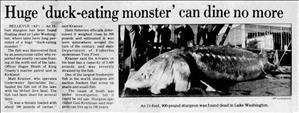On November 5, 1987, biologists with the Washington Department of Fish and Wildlife haul out perhaps the biggest fish ever seen in Lake Washington. Weighing 670 pounds and measuring 11 feet long, from tail to snout, the massive white sturgeon (Acipenser transmontanus) is estimated to be up to 100 years old. She is neither the first nor the last of her species to inhabit the lake.
Migrating Fish
Lake Washington has long had the potential to be visited by white sturgeon (Acipenser transmontanus). With its many bays, average depth of 108 feet and maximum depth of 214 feet, the lake has more than enough space to be home for fish that can top out at 1,500 pounds and 20 feet long. Members of a group of bony fishes that coexisted with ammonites, sturgeon are migratory fish that spend most of the year in estuaries but swim up rivers to spawn. For example, they historically swam up the Columbia River (Lewis and Clark reported seeing them in the river in 1806) into the Snake River to spawn in Idaho, so reaching Lake Washington would have been just a minor trip for the fish.
More than likely, the big fish swam into a sort of proto-Lake Washington when the Puget lobe of the Cordilleran Ice Sheet melted out of the Puget Lowland around 15,500 years ago. For several hundred years prior, the proto-Lake Washington was connected to salt water (to a sort of proto-Puget Sound), and could have provided estaurine habitat for sturgeon. Around 14,800 years ago that connection was severed and the lake became fresh. The cutting off of the direct, non-river linkage between salt and fresh water, however, wouldn’t have prevented sturgeon from entering Lake Washington, as they could have swum into Elliott Bay and up the Duwamish River to the Black River (the lake’s original outlet, at the south end in Renton) and into the lake. They could have continued to make this journey until 1916, when the creation of the Lake Washington Ship Canal severed that connection. Afterward, sturgeon could have entered the lake directly via the locks. In November 2016, one was found during the annual draining of the locks. Employees captured the fish and released him/her back into Puget Sound.
Because the fish are mostly cartilaginous and not bony, they tend not to preserve as well as might be suspected for such large animals. Despite this issue, sturgeon have bony elements such as scales, or scutes, which have been found in archaeological deposits, including in British Columbia and Oregon (dating to between 100 and 800 CE), as well as at a site in the Tulalip/Snohomish River estuary.
Deep Secrets
As far back as the 1950s, stories of sturgeon possibly lurking in Lake Washington appeared in the local papers. One story by the aptly named William L. Pollock in The Seattle Times noted the possibility of "1,500-pound sturgeon" in the lake, though none had been caught yet ("Grab-Bag Fishing"). Not until November 5, 1987, was a dead sturgeon found; it was floating on the surface of the lake near Kenmore. Initial rumors said the great producer of caviar weighed between 2,400 and 5,000 pounds; it turned out that the fish weighed a mere 670 pounds with about 100 pounds of eggs. She was 11 feet long. Biologists estimated that she was between 80 and 100 years old.
Biologists and the public wanted to know how she got into Lake Washington and how long had she called it home. A November 8, 1987, article in The Seattle Times quoted 77-year-old Art Corbus, who said, "I saw a sturgeon in 1922 off what is now south Kirkland. They told us at the time that sturgeons had been let loose from the Alaska-Yukon-Pacific Exposition" in 1909 ("It Was Fishy ..."). This appears to be the first time the AYP-origin fish story was reported, as no previous article in the local papers that mentioned the possibility of sturgeon in Lake Washington had made this claim.
No corroborating evidence, such as records from the AYP or newspaper articles, backs up Corbus’s statement. In contrast, biologists have records that one species of fish, the tench (Tinca tinca), a European native, was initially dumped after the fair into Drumheller Fountain on the University of Washington campus, and then transferred to Lake Washington. Sturgeon were at the AYP in the Oregon State Building and the Forestry Building. An April 25, 1909, article in The Seattle Times claimed that the 300-pound sturgeon had been "captured when a mere child and ... [was] stall fed and reared as a pet. He readily responds when called by name" ("Port Townsend Has Trained ..."). If this is true, and someone went to the effort of raising this sturgeon to be a pet, it seems unlikely the fish would have been released after the fair.
Biologists for the Washington Department of Fish and Wildlife don’t doubt that sturgeon exist in Lake Washington. They were also sighted in 2005 (5.5 feet long, caught by a University of Washington research boat); 2013 (8 feet long, dead, August 3, near Matthews Beach); and 2023 (8 feet long, September 6, Kenmore). "We feel like there are probably more than a handful of large sturgeon that found their way into the lake or were born there and never left and have just adapted to a full freshwater existence. Given that they can eat almost anything they can get in their mouths (which are large), there is certainly enough food in Lake Washington for them to survive," says Robert Pacunski, a state fisheries biologist.

